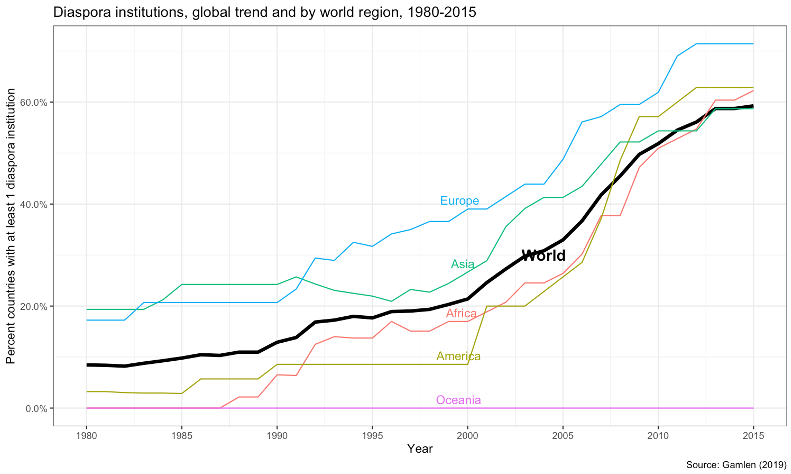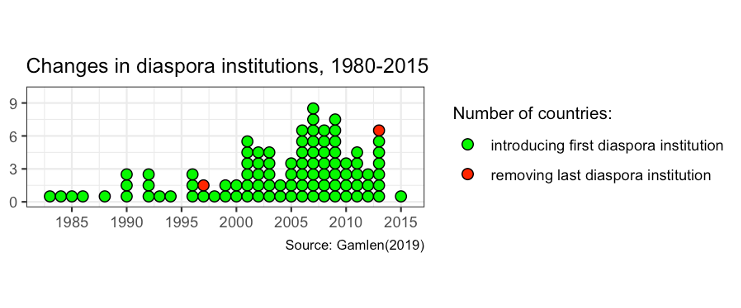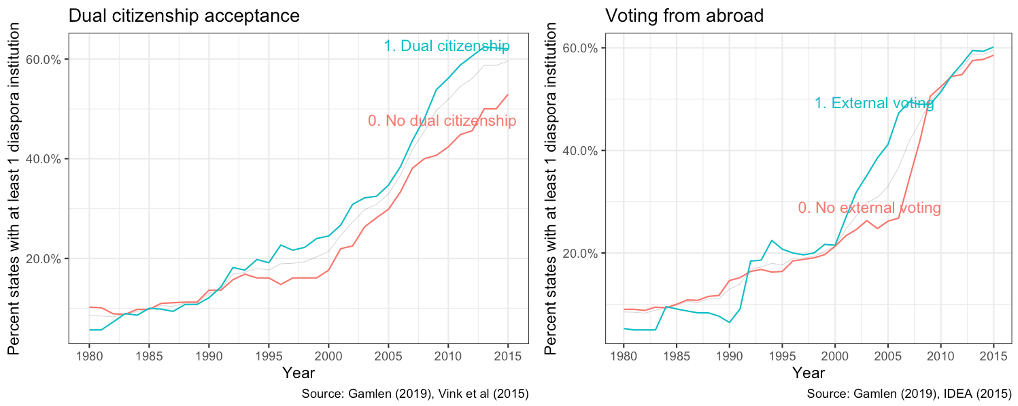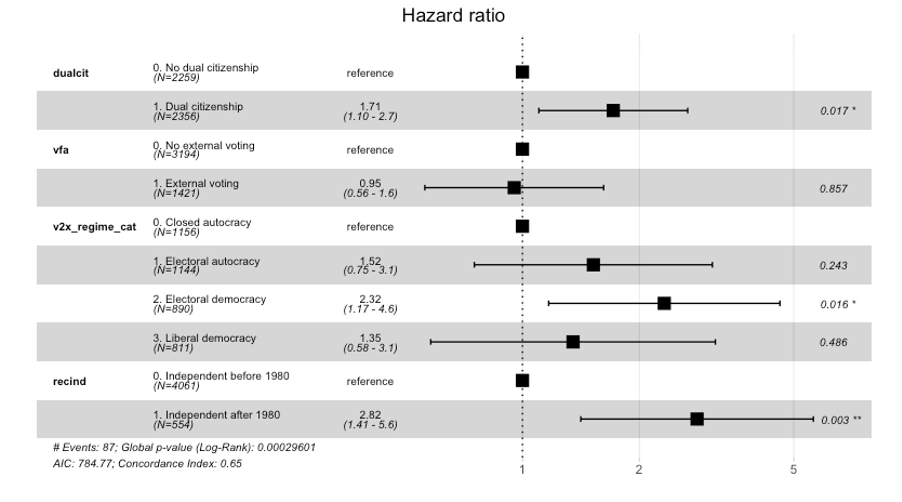COMMENT
Human Geopolitics and the Reconfigurations of Citizenship
Maarten Vink, Maastricht University
Diasporas are not what they used to be, says Alan Gamlen in his new book Human Geopolitics. Whereas the term ‘diaspora’ was once reserved for archetypical groups maintaining an intact identity despite traumatic dispersion in the distant past, nowadays the term has been opened up and is frequently used in the context of mobilising emigrant communities in relation to their countries of origin. “From groups defined in opposition to nation-states”, Gamlen observes (p. 7), “diasporas have gradually become organs of states and of the inter-state system”.
The main focus of this theoretically and empirically rich book is on the rise of ‘diaspora institutions’, which are defined by the author as “formal state offices dedicated to emigrants and their descendants” (p. 9). Diaspora institutions can take various forms and Gamlen’s focus in this book is on formal state offices, such as fully-fledged diaspora ministries, diaspora departments within (typically) foreign ministries, or other institutions such as interdepartmental committees or special electoral constituencies representing emigrant voters. Among these, the second category is most common with almost half of UN member states having at least one diaspora department by 2015 (p. 42).

By 2015, as visualised in Figure 1[1], nearly 60 percent of all states in the world had at least one diaspora institution. As already visible in Figure 1, but more clearly in Figure 2, whereas the introduction of diaspora institutions was more sporadic until the early 1990s, from the mid-1990s and especially since the new millennium, the introduction of formal state offices dedicated to emigrants and their descendants has rapidly increased. By 2015, Gamlen’s study observes, 118 states maintain at least one diaspora institution (p. 9).

In this book Gamlen aims to understand how and why this is happening. While existing approaches focus either on economic, political and security interests of states (‘tapping’) or on identity and national unity (‘embracing’), Gamlen goes beyond these domestically oriented accounts and focuses his argument on “the international forces shaping state behaviour from the outside” (p. 12). Briefly stated, in his view, the rise of diaspora institutions is a reflection of the ‘emerging global migration regime’ in which ‘engaging diasporas’ is encouraged as part of a set of best practices through which states are increasingly expected, through informal, non-binding and state-led dialogue, to treat interference with ‘their’ citizens abroad as part of normal politics (pp. 12-13).
Overall, I am very sympathetic to this ‘policy mobilities’ account of what Gamlen sees as “the new wave of human geopolitics” (p. 13). This may not surprise, in light of my own related recent work with colleagues on the international diffusion of expatriate dual citizenship (Vink et al 2019, see here). I fully agree that trying to understand and explain the rise of diaspora institutions (or dual citizenship) solely from a domestic perspective focused on “internal strategic or nationalist drivers of individual state actions” (p. 12) would miss out on grasping a phenomenon that is international in essence. This is clearly where the ambitious empirical scope of this book has significant added value, as picking out any or just a few of the numerous cases of diaspora institutions could have easily resulted in very plausible ‘tapping’ or ‘embracing’ accounts. By linking the ‘dramatic’ (p. 183) global trend demonstrated in the first, quantitative part of the book with qualitative accounts of international model-setting and emulating policy entrepreneurship, in the second part of the book, Gamlen skilfully manages to avoid the perils of methodological nationalism.
This is not to say that Gamlen does not account for relevant domestic developments. By contrast, regime characteristics are a core element of an account of what he sees as the first phase in the worldwide spread and normalisation of diaspora institutions. In Chapters 3 and 4, Gamlen develops and illustrates the argument of how ‘regime shocks’ (i.e., “moments of disruption to prevailing configurations of territory, sovereignty, and/or citizenship that define a specific place”, p. 53) explain the introduction of diaspora institutions as a reflection of ‘exile ingathering strategies’. In this section of the book, Gamlen links the human geopolitical strategies of reaching out to compatriots abroad to the ‘cushioning’ of regime shocks and consolidation of post-colonial nation-states (p. 125). In the subsequent sections of the book, he then outlines how the emergence of diaspora institutions began to take on a different and more normative logic, connected with the rise of regional integration schemes (Chapter 6), competitive post-Soviet regional integration processes in Europe and Eurasia (Chapter 7) and the globalisation of diaspora engagement through a newly emerged migration and development discourse within the bureaucracy of international institutions as the IOM, World Bank and the UN (Chapters 8-9). Chapter 10, finally, argues that it would be short-sighted to solely perceive of the diffusion of diaspora policies as the result of a top-down imposition of new policy paradigms on origin states by international organisations and their wealthy donors; rather, Gamlen argues, we should perceive this as an “iterative process of co-creation and adaptation, with policy models mutating as they wash through networks of internationally linked actors” (p. 240).
What makes this book commendable is the way in which Gamlen ties the rich empirical material in the qualitative part of the book to the nuanced argument about policy mobilities. In this sense, Gamlen avoids the trap in which much quantitative policy diffusion literature falls, namely observing patterns of policy mobility (typically between neighbouring political units, such as countries or lower level units such as states or cities) without convincingly identifying underlying causal mechanisms (Magetti and Gilardi 2016).
Gamlen’s quantitative analysis does leave room to further explore the data on diaspora institutions he collected and to identify relevant patterns beyond the descriptive trends that are currently highlighted in the first part of the book (for a systematic analysis see Gamlen et al. 2019). My main curiosity, in this context, relates to what Gamlen views as the reconfigurations of territory, sovereignty and citizenship, which open up political space for rethinking the relation between a state and citizens beyond its territory. Gamlen places such reconfigurations exclusively in what he sees as a first stage of normalisation of diaspora institutions, from the mid-20th century to the early 1990s (p. 16), around regime shocks related to decolonialisation and the disintegration of the Soviet Union. Yet what about reconfigurations of citizenship in the subsequent waves of normalisation? Even if changes in the international institutional environment are key to shaping states’ approaches to the relation with their diaspora abroad, should we not expect that states will be more receptive to such ideational changes if their domestic context is already geared towards notions of citizenship that supersede territorial boundaries? For example, in the context of strategic state competition over populations, central to Gamlen’s argument, one might expect that outward-looking states that already allow their citizens to naturalise abroad or those that allow their citizens to vote from abroad are more receptive to ideas being pushed on the domestic agenda about actively maintaining economic and political links with the diaspora. By contrast, inward-looking countries without external franchise or with restrictive expatriate dual citizenship policies may be expected less likely to have diaspora institutions in place.

Such expectations are partially confirmed by the descriptive global trend of diaspora institutions, by external franchise and dual citizenship acceptance (Figure 3). Countries which allow their diaspora to naturalise abroad while maintaining their origin citizenship broadly speaking are more likely to have a diaspora institution in place; though this becomes noticeable only from the mid-1990s. With regard to voting from abroad, beyond some difference in the speed at which countries adhered to the global trend over the early 2000s, by 2015 countries are equally likely to have diaspora institutions, irrespective of whether they have external franchise in place or not.
As a side note, whereas I would have expected the Netherlands – as a country with a generally restrictive expatriate dual citizenship policy (though with notable exceptions) – to reflect this logic, Gamlen in fact codes the introduction of an International Migration and Development Division at the Ministry of Foreign Affairs in 1998 as a new diaspora institution (Appendix I). I am not convinced that this particular instance merits such coding given that this department – to my knowledge and as suggested by the cited source reference (Agunias and Newland 2012) – seems exclusively focused on engaging migrant diasporas from other countries in the development of those countries (see also p. 221). Hence, in contrast with many other cases included in Gamlen’s list that are explicitly focused on the engagement of ‘compatriots living abroad’ (Russia), coding the Dutch ‘migration and development department’ as a diaspora institution seems misplaced, among an otherwise plausible list of institutions.
The statistical relevance of dual citizenship policy and voting from abroad (vfa) is confirmed once we run a Cox proportional hazards regression to model some basic correlates of the propensity to introduce the first diaspora institution (Figure 4).[2] Countries that accept dual citizenship (HR: 1.71; 95% CI: 1.10-2.7) are more likely to introduce a first diaspora institution, suggesting the interlinking between diaspora governance and dual citizenship. For countries with external voting, by contrast, we find no significant difference (HR: 0.95; 95% CI: 0.56-1.6).[3] The model also confirms Gamlen’s expectation that recently independent states (operationalised here as those that became independent after 1980) are more prone to introduce diaspora institutions (HR: 2.7; 95% CI: 1.45-5.0). While this basic model does not invalidate an argument about policy emulation (an interesting question would be how to operationalise the notion of the emerging global migration regime in such a quantitative model),[4] it does suggest that some states may be more likely to jump on the bandwagon of the international community than others.

To conclude, Gamlen’s Human Geopolitics makes a convincing argument for the changing nature of diaspora governance based on a comparative mixed-method study with an impressive global and longitudinal scope. The book provides a compelling story about the political drivers of this process and invites scholars to further explore, both qualitatively and quantitatively, geographic and temporal variation in adherence to this new global trend. The original data collected by the author will doubtless be in high demand not just among migration and diaspora scholars, but also within the field of citizenship studies at large.
Notes
[1] I thank Alan Gamlen for making the dataset of Human Geopoliticsavailable for the purpose of data visualisation and exploration in this review. All graphs included here were produced by me on the basis of these data (1980-2015), combined with my own data on dual citizenship (Vink et al. 2015), V-DEM data on political regimes (Coppedge et al. 2019) and IDEA data on voting from abroad (IDEA 2015). Given the increasing number of independent states between 1980 and 2015, I visualise the percentage of states with diaspora institutions instead of the absolute number of states with such institutions (cf Figure 2.3, pp. 36-37).
[2] See also Gamlen et al (2019) for a similar empirical approach.
[3] Additional analysis shows that a dynamic measure of whether a country has introduced external voting in the past three years is positively associated with the propensity to introduce diaspora institutions (results not shown here)
[4] See Gamlen et al (2019), Table 1 for operationalisations of the tapping perspective, embracing perspective and governing perspective.
